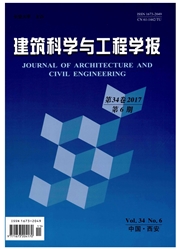

 中文摘要:
中文摘要:
为研究玄武岩纤维增强复合材料(BFRP)筋与混凝土的粘结-滑移本构关系,探讨BFRP筋与混凝土的受力过程,对16组共96个不同参数的粘结试件进行拉拔试验,每组选取1个试验结果,得到试件的粘结-滑移曲线。将BFRP筋与混凝土的粘结-滑移曲线细分为微滑移阶段、滑移阶段、下降阶段和残余应力阶段共4个阶段。基于试验结果,在已有的粘结-滑移本构模型基础上进行改进,建立了适用于BFRP筋与混凝土粘结-滑移本构关系的理论模型。研究结果表明:微滑移阶段粘结-滑移曲线近似于直线上升,滑移阶段粘结-滑移曲线逐渐偏离直线呈非线性上升,下降阶段粘结-滑移曲线近似于线性下降,残余应力阶段粘结-滑移曲线近似于周期性递减的正弦函数;该模型与试验结果吻合良好,能较好地反映BFRP筋与混凝土之间的受力过程,可为今后BFRP筋与混凝土锚固性能的理论分析和工程应用提供参考。
 英文摘要:
英文摘要:
In order to investigate the bond-slip constitutive relation between basalt fiber reinforced polymer (BFRP) bar and concrete, as well as to study the loading process, the tests on ninety-six bonding specimens of different parameters in sixteen groups were made. Bond-slip curves of specimens were drawn on the basis of test results selecting one from each group. The bond-slip curves of BFRP bar and concrete were composed of four segments: micro-slippage segment, slippage segment, descending segment and residual segment. Based on the test results, the theoretical model applied to bond-slip constitutive relation between BFRP bar and concrete was made through improving the existing model. The research results show that the micro-slippage segment bond-slip curves are close to a straight line increased change; the slippage segment bond- s[ip curves irLcreasingly deviate from a straight line to the nonlinear increased change; the descending segment bond-slip curves are similar to linear decrease; the residual segment bond-slip curves are sine function similar to the periodic decline function. The new model coincides well with the test results, which can reflect perfectly the loading process of BFRP bar and concrete. The research can provide reference for theoretical analysis and engineering application on bondanchorage properties of BFRP bar and concrete in the future.
 同期刊论文项目
同期刊论文项目
 同项目期刊论文
同项目期刊论文
 期刊信息
期刊信息
